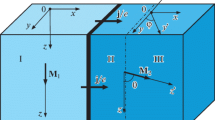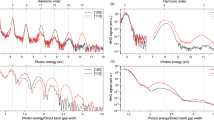An oscillatory character of the variation of the degree of polarization is observed and is due to recombination of spin-polarized electrons in a variable-gap semiconductor in a magnetic field, as a function of the energy of the emitted quanta at a fixed magnetic field, and as a function of the magnetic field at a fixed quantum energy.
Similar content being viewed by others
1. Optical orientation of the electron spins in semiconductors has been under intensive study in recent years. Spin-polarized electrons are excited by circularly polarized light, and the degree of their orientation is determined directly from the degree of polarization of the recombination radiation. A magnetic field H perpendicular to the exciting light beam causes precession of the spins around the field direction. The recombination radiation consists of photons produced upon recombination of electrons whose spins are in different rotation phases. As a result, in an ordinary semiconductor, where the optical transitions that occur at different points of the crystals are energy-wise equivalent, the magnetic field causes depolarization of the radiation. The polarization preserves the sign in this case, since the number of electrons with initial spin orientation is always maximal as a result of the recombination and relaxation processes [1].
2. The polarization of the recombination radiation should have a qualitatively different character in the case of a variable-gap semiconductor—a semiconductor with a continuously variable forbidden-band width inside the crystal. In such a semiconductor, the optical transitions that occur at different points of the crystal turn out to be energy-wise not equivalent, and therefore the emission spectrum should carry information concerning the motion of the carriers and their spins.
Figure 1 shows the energy diagram of a variable-gap semiconductor of p-type, exposed to stationary illumination from the side of the wide-band surface, by circularly polarized light with photon energy hνi. This light excites electrons with spins oriented along the x axis. The electrons drift under the influence of the quasi-electric field of the variable-gap semiconductor in the direction of the decreased width of the forbidden band and diffuse, gradually vanishing as a result of recombination. The electron spins behave in similar fashion, the only difference being that the average spin per electron can vanish also as a result of relaxation processes. In a transverse magnetic field, the spins will also precess as they move. As a result, the spins arrive at different points of the semiconductors with different phases, determined by the time of motion and by the precession rate (by the magnitude of the magnetic field). Since different points of the crystal differ in the energy of the emitted quanta, this leads to the appearance of oscillations of the degree of polarization in the spectral emission band of the variable-gap semiconductor. The degree of polarization of the radiation emitted in a direction opposite to the exciting beam is proportional to the x-component of the average spin per electron. If the spin executes one complete revolution in the course of its drift–diffusion motion, then the degree of polarization of the radiation reverses sign twice as a function of the energy of the emitted photons (hν), and executes one complete oscillation. For example, according to Fig. 1, where the spins of the electrons are arbitrarily designated at different points of the semiconductor, the recombination radiation emitted in a direction opposite to exciting beam will have right-hand circular polarization for the photon energy hν1, no polarization at hν2, and left-hand polarization at hν3.
Thus, the degree of polarization of the radiation of the variable-gap semiconductor in a magnetic field should have an alternating-sign oscillatory character as a function of the energies of the emitted photons. With increasing magnetic field, the period of the oscillations should decrease because of the increase in the precession frequency of the spin, and the damping of the oscillations should increase, reflecting the dephasing of the spins as a result of diffusion.
At a fixed emission-photon energy (hν < hνi), the degree of polarization should also oscillate with increasing magnetic fields, since the direction of the spin with which the electron arrives at a given point of the crystal (with Eg = hν) changes with increasing H as a result of the increased precession frequency.
3. For an experimental observation of the oscillations of the recombination-radiation polarization we used variable-band crystals p-(GaAl)As, in which the width of the forbidden band decreases with a gradient of 160 eV/cm, from a value 1.98 eV on the illuminated surface. The crystals were grown by liquid epitaxy and were doped with zinc to a hole density (3–5) × 1017 cm–3. We registered the recombination radiation emitted in a direction opposite to that of the exciting beam. The crystal temperature was 77 K. The stationary excitation of the nonequilibrium carriers was effected by circularly polarized light of an He–Ne laser (hνi = 1.959 eV).
Figure 2 shows plots of the intensity difference between the right- and left-hand polarizations (I+ – I–) against hν without a magnetic field and at different values of the transverse magnetic field. At H = 0, the difference (I+ – I–) = f(hν) decreases exponentially with decreasing hν, remaining positive. In a magnetic field, the difference (I+ – I–) = f(hν) is of alternating sign, decreasing in amplitude with increasing magnetic field. The energy period of the oscillations of the difference (I+ – I–) decreases with increasing H.
As follows from Fig. 2, at a fixed value of hν the difference (I+ – I–) = f(H) has also an oscillatory character as a function of the magnetic field.
4. The experimentally observed effect of the oscillations of the polarization of recombination radiation of a variable-band semiconductor in a magnetic field is theoretically treated by us elsewhere [2]. The formulas given there make it possible, using the experimental data, to determine the parameters that characterize electron transport in a variable-gap semiconductor, namely the lifetime of the nonequilibrium electrons τ = 1.1 × 10–9 s, the spin-relaxation time τ = 4.0 × 10–10 s, and the nonequilibrium electron mobility μc = 8 × 103 cm2/(V s). We used in the calculation the values of the g factor as given by Hermann et al. [3].
REFERENCES
R. R. Parsons, Can. J. Phys. 49, 1850 (1971);
A. I. Ekimov and V. I. Safarov, JETP Lett. 12, 198 (1970);
B. P. Zakharchenya, V. G. Fleisher, R. I. Szhioev, Yu. P. Veschunov, and I. B. Rusanov, JETP Lett. 13, 137 (1971).
A. S. Volkov and G. V. Tsarenkov, Sov. Phys. Semicond. 11, 1004 (1977).
C. Hermann, G. Lampel, and C. Weisbuch, in Proceedings of the 13th International Conference on Physics of Semiconductors, Rome, 1976, p. 130.
Funding
This work was supported by ongoing institutional funding. No additional grants to carry out or direct this particular research were obtained.
Author information
Authors and Affiliations
Corresponding author
Ethics declarations
The authors of this work declare that they have no conflicts of interest.
Additional information
Publisher’s Note.
Pleiades Publishing remains neutral with regard to jurisdictional claims in published maps and institutional affiliations.
Rights and permissions
Open Access. This article is licensed under a Creative Commons Attribution 4.0 International License, which permits use, sharing, adaptation, distribution and reproduction in any medium or format, as long as you give appropriate credit to the original author(s) and the source, provide a link to the Creative Commons license, and indicate if changes were made. The images or other third party material in this article are included in the article’s Creative Commons license, unless indicated otherwise in a credit line to the material. If material is not included in the article’s Creative Commons license and your intended use is not permitted by statutory regulation or exceeds the permitted use, you will need to obtain permission directly from the copyright holder. To view a copy of this license, visit http://creativecommons.org/licenses/by/4.0/.
About this article
Cite this article
Volkov, A., Ekimov, A., Nikishin, S. et al. Oscillations of Polarization of Recombination Radiation of a Variable-Gap Semiconductor in a Magnetic Field. Jetp Lett. 118 (Suppl 1), S18–S20 (2023). https://doi.org/10.1134/S0021364023130131
Received:
Revised:
Accepted:
Published:
Issue Date:
DOI: https://doi.org/10.1134/S0021364023130131






